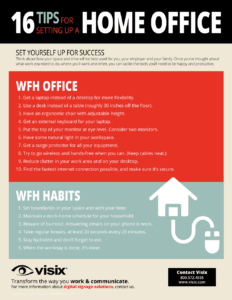More people working from home means remote engagement will be more important than ever in the future. Everyone in the organization, from the C-suite to managers to employees both in and out of the office will need to adopt new tools to stay connected, focused and productive. Technology, as always, will play a main role.
The Home Office
For people working remotely to do their very best, their home office has to be set up for success. The organization should evaluate each employee’s technical needs and provide the necessary tools and equipment, as well as IT support. They can either purchase equipment outright or reimburse people for things they buy on their own.
In terms of ergonomics, employers will have to decide how much they want to be involved in decisions like desks, chairs and lighting. At the very least, WFH employees can get some tips and advice on how to optimize their home office environment. Organizations should compile a list of useful tips for virtual employees and make it available to them.
Business Communication Platforms
With employees spread out across a city or across the globe, organizations are adopting enterprise platforms to help employees work better together. Collaboration and communication platforms like Microsoft Teams, Slack, Google G Suite, Workplace for Facebook and others had already taken root, but became critical systems in 2020.
The advantages of these platforms aren’t restricted to remote employees. Instead, they allow everyone in the company to access a central system for chats, conversations, files, calendars, voice and video meetings, and integrated apps. All of the most popular platforms have both desktop and mobile versions so people can stay connected wherever they are. And when people stay connected, that boosts remote engagement.
If your organization hasn’t already settled on an enterprise platform, now is the time. Many companies resorted to multiple apps to handle the unexpected increase in remote workers, and mastering so many different workflows has added stress to already stressed workers. Landing on a single, enterprise platform will let you devote more resources to training and developing best practices, rather than managing multiple apps.
Of course, when deciding on a platform, the business will have to consider what budget’s right for them, as well as features and other considerations (IT support, update frequency, subscription terms). But it could be a mistake to make a final decision without soliciting employee input. People are much more likely to adopt and use technology that they prefer, so ask your workforce what features, apps or perks they’d like to have. Consider a trial period for employees to evaluate different options. Even if you have to choose a platform that didn’t garner the most votes, explain why and invest in training.
Digital Signage Evolves
As remote engagement has betcome more important, digital signage has evolved to let organizations expand the reach of their visual communications.
We’ve known for years that digital signage is an incredibly effective way to communicate with people. Four out of five companies that use digital signage see an increase of up to one-third more sales, especially in the retail sector. More and more organizations are planning to implement a digital signage system in the next couple of years or increase one they’ve already been using, including 56% of internal communications professionals in North America.
Messages seen on digital signs get 400% more views than static displays and have an astonishing 83% recall rate. Companies that use digital signage as part of their internal communications strategy find their employees are 25% more productive and report a fourfold increase in employee engagement. And employees who are recognized on digital signs feel more appreciated, which results in their being 60% more productive than people who receive recognition through other means. Stats about the effectiveness and impact of digital signage have been trending up for years and aren’t expected to lag any time soon.
But how does adding remote workers into the mix change things? Traditionally, digital signage required people to be physically in a space, looking at a physical screen. To a certain extent, that’s still true. However, neither the person nor the screen has to be in your office for it to be digital signage. Anything with a screen can be a digital sign.
As content management systems have evolved, more and more endpoints have become available. It used to be just displays mounted on walls. Then touchscreens, video walls and room signs came along to extend the reach for visual communications. Now the technology has evolved again to let you send messages or playlists to responsive webpages, embed them in intranets, or even push them to enterprise apps like Teams. Some can even send your messages via email.
These new endpoints, paired with traditional screens, can all be part of a comprehensive visual communications network that lets you connect with more people in more workspaces – all managed from a single source. By messaging out to people where they are and the way they prefer, you ensure that everyone’s on the same page and more connected to the organization as a whole.
The trick for communicators is that omni-channel thinking lets them truly unify how they communicate. Don’t create an email, and then a message for digital signs and then a post for Teams and then another one for social media; create one that works on all those platforms and then schedule it to go out to all those different platforms at once. This gives your audience the option to use the method they like best, and it also provides reinforcement if they see your message in more than one place.
Think about how digital signage transforms the way in which people interact with your messaging. For many years now, visual communications have been shifting from push-only messages to dynamic, interactive content.
Instead of just informing people, digital signage has also been connecting them to your communications and one another. Everyone sees the messages, then some of them talk about it, which drives more people to look for them and so on. Wayfinding has gone to interactive touchscreens and directions can even be sent directly to a person’s mobile device. QR codes let people use a web browser to get more information, fill out questionnaires and forms, and so on.
Remote engagement is all about continuing to encourage these trends and extend them out to WFH employees. It doesn’t matter where they are, they should all be getting the same information and the same opportunity to interact with your communications.
Space Management
Any facility that’s using office hoteling will also need a good room reservation system that updates in realtime and is accessible to everybody, regardless of where they’re located. The ability to book meeting rooms and collab spaces for face-to-face interactions will become even more important, as a hybrid workforce will need to ensure the spaces they reserve have the videoconferencing and collaboration tools they need. Some organizations may opt not to kit out every room, so they might also have reservation systems for equipment, like monitors, webcams and videoconferencing setups.
By adopting new technologies and new processes that benefit everyone in your organization – no matter where they’re working from – remote engagement will become just another subset of your overall communications and engagement strategy.

